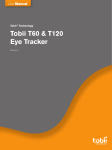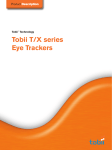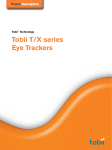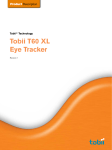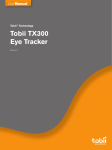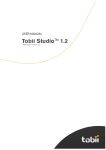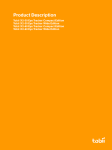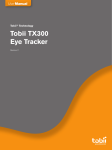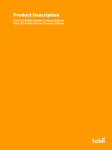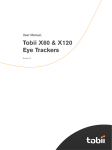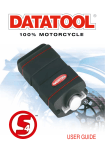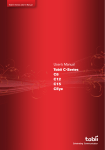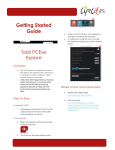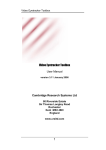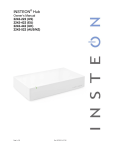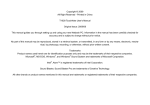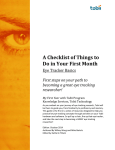Download Tobii Pro T60XL User Manual
Transcript
User Manual Tobii® Technology Tobii T60 XL Eye Tracker Revision 2 www.tobii.com User Manual On Safety Read this manual carefully before connecting and using the eye tracker The Tobii T60 XL Eye Tracker is intended only for use in office and home environments. Do not open the eye tracker! Non-compliance will result in loss of Warranty! There are no user serviceable components inside and the risk of electric shock is high due to the presence of Dangerous High Voltages. Contact Tobii support if your eye tracker is not working properly. Safety of NIR illumination from the Tobii T Series Eye Trackers The illuminators of the Tobii T60 XL Eye Trackers have been tested at ETL SEMKO, Stockholm, according to IEC/EN 60825-1/A1-A2. The test has shown that the products comply with the standard for IEC/EN 60825-1/A1-A2 class 1 LED products intended to be used for long time exposure. The standard IEC/EN 60825-1/A1-A2 states an Accessible Emission Limit (AEL) for continuous long time exposure. This limit is the maximum illumination that a person should be exposed to for eight hours a day many days in a row. The products are intended to be used by a subject at a distance of approximately 60 cm from the eye tracker. At the regular user distance the exposure, averaged over time, of light from the Tobii T60 XL Eye Tracker to the subject sitting in front of it is 0.1 % of the allowed limit for long time exposure according to IEC/EN 60825-1/A1-A2 class 1 LED products. Epilepsy warning Some people with Photosensitive Epilepsy are susceptible to epileptic seizures or loss of consciousness when exposed to certain flashing lights or light patterns in everyday life. This may happen even if the person has no medical history of epilepsy or has never had any epileptic seizures. Such people may have a seizure while watching certain images or patterns on a monitor, or even when exposed to the light sources of an eye tracker. It is estimated that about 3-5% of people with epilepsy have this type of photosensitive epilepsy. Declaration of Conformity This equipment has been tested and found to comply with the limits for a Class B digital device, pursuant to part 15 of the FCC Rules and EMC directive 2004/108/EG. The product also conforms with the directive 73/23/EEC for low voltage and environmental directives 2002/95/EC and 2002/96/EC. Note: This equipment has been tested and found to comply with the limits for a Class B digital device, pursuant to part 15 of the FCC Rules. These limits are designed to provide reasonable protection against harmful interference in a residential installation. This equipment generates, uses and can radiate radio frequency energy and, if not installed and used in accordance with the instructions, may cause harmful interference to radio communications. However, there is no guarantee that interference will not occur in a particular installation. If this equipment does cause harmful interference to radio or television reception, which can be determined by turning the equipment off and on, the user is encouraged to try to correct the interference by one or more of the following measures: • • • • Reorient or relocate the receiving antenna. Increase the separation between the equipment and receiver. Connect the equipment into an outlet on a circuit different from that to which the receiver is connected. Consult the dealer or an experienced radio/TV technician for help. All Tobii Eye Trackers are CE-marked, indicating conformity with the essential health and safety requirements set out in European Directives. 2 Tobii T60 XL Eye Tracker Table of Contents • • • Quick Start ........................................................................................................................4 First time usage ............................................................................................................................................4 Components checklist ............................................................................................................................4 • Product Care ..................................................................................................................5 • • • • • • • • • Connecting Tobii Eye Tracker .............................................................................. 7 Setting up the connection to your computer .....................................................................7 Installing the USB Ethernet Adapter ........................................................................................7 Installing the USB User Camera Driver.......................................................................................7 Installing eye tracker software.............................................................................................................7 Setting up the network connection to the eye tracker in Windows ................ 8 Connecting to the eye tracker in Tobii Studio.....................................................................10 Connecting to the eye tracker in ClearView or Tobii SDK.......................................10 Setting the IP address in ClearView............................................................................................11 • • • • Configuration and settings......................................................................................12 General setup guidelines.......................................................................................................................12 Setup example.................................................................................................................................................12 Minimum system recommendations............................................................................................13 • • • • • • Parts and Controls........................................................................................................14 Front display.......................................................................................................................................................14 Left side panel - connections.............................................................................................................14 Left side panel - controls.......................................................................................................................15 Right side panel - power.........................................................................................................................16 Mounting the Tobii T60 XL on an alternative foot..........................................................16 • Customizing the Eye Tracker’s Display............................................................17 • • Appendix I: Eye Tracker Upgrade........................................................................21 Eye tracker software upgrade...........................................................................................................21 • • • Appendix II: Troubleshooting Guide..................................................................22 Problems with the Apple Bonjour Service..............................................................................22 Problems with the peer-to-peer network configuration.............................................23 • • • • Appendix III: Technical Specifications.............................................................24 Tobii T60 XL Eye Tracker......................................................................................................................24 Glossary - technical specifications................................................................................................25 Eye tracker data output...........................................................................................................................26 Tobii T60 XL Eye Tracker User Manual This document contains information proprietary to Tobii Technology AB . The contents are confidential and any disclosure to persons other than officers, employees, agents or subcontractors of the owner or licensee of this document, without the prior written consent of Tobii Technology AB, is strictly prohibited. No part of this publication may be reproduced, stored in retrieval system, or transmitted in any form or by any means, electronic or mechanical, including photocopying and recording, without the prior consent of the copyright holder. Manual release 2.0, October 2010 Tobii Technology AB reserves the right to change the content of this manual without prior notice. Changes due to typographical errors, inaccuracies or modifications in programs and/or equipment might be implemented at any time. Please check the Tobii web site www.tobii.com for updated versions of this document. All rights reserved. © Tobii Technology AB 3 User Manual Quick Start First time usage 1. Step 3. First time usage Configure the network card Install and configure the separate USB Ethernet adapter, configure the built in network card in your computer, your network router, or your office LAN. For complete details see pages 7-8. 2. Power cable Install the eye tracker software Install Tobii Studio or Tobii Eye Tracking Tools. For complete details see page 7. 3. Connect the eye tracker to your computer Connect the Power, DVI and LAN cables and turn on the eye tracker by pressing the power button. Press the Source button to choose the input mode (Digital). See figures on the left. For details on connecting the User Camera and Built-in Speakers read page 7. Right side panel DVI-D cable 4. Reboot your computer 5. Connect the eye tracker to Tobii software Start Tobii Studio or other supported software and make sure the eye tracker is connected. For complete details see pages 8-10. 6. Adjust your physical setup Adjust the physical setup of the eye tracker and other devices. For details see page 11. LAN cable 7. Create your Project and Tests in Tobii Studio For details read chapter 4 of the Tobii Studio User Manual. 8. Calibrate and record in Tobii Studio For details read chapter 4 of the Tobii Studio User Manual. Left side panel Power button Component checklist • Tobii T60 XL Eye Tracker • Computer with Tobii Studio or other supported software (Download the Tobii System Recommendations document from www.tobii.com) • Tobii Studio or Tobii T/X Series Eye Trackers Resources CD • Power supply cable Right side panel • DVI-D cable • LAN cable Source button • USB - LAN Adapter • Audio Cable Left side panel 4 • User Camera USB Cable A/B Tobii T60 XL Eye Tracker Product Care Temperature and humidity Do not place the eye tracker in places subject to extreme temperatures and humidity, such as on top and or near a heating element, or in a damp room. Do not expose the eye tracker to direct sunlight. Failure to comply may lead to equipment damage due to high temperature exposure. The recommended range of temperatures and humidity values are: Storage temperature: 0°C to +35°C / 32°F to 95°F Storage humidity: Max. 70%, no condensation Usage temperature: +20°C to +35°C / 50°F to 95°F Usage humidity: Max. 80%, no condensation Placement Only use arms and stands specified by the supplier and make sure that they are mounted and fastened correctly according to the instructions. Do not place the eye tracker on unstable and uneven surfaces. Avoid places subject to strong mechanical vibrations or shock. The eye tracker should not be operated on moving vehicles. Do not cover the ventilation openings of the eye tracker. If these openings are covered built up heat may cause failure and a possible fire hazard. Ingress protection IP class 20. No protection against objects smaller than 3.5mm. Do not place the monitor in places with large amounts of dust, dirt or sand, for example, near an open window or an outdoor exit. If setting up temporarily in an outdoor location take adequate precautions against airborne dust and dirt. Do not use the eye tracker near water. The eye tracker is not water resistant. Mechanical shock If the eye tracker is exposed to mechanical shock, for example, when dropped, do not try to connect it to a power source. Contact Tobii support. Power It is recommended that you connect the power cable of the eye tracker and computer to an outlet with a protective earth/ ground connection. Use an accessible outlet and make sure that the cables are properly placed to avoid a possible trip hazard. Do not try to replace, repair or bypass a blown fuse. A blown fuse is an indication that there is a malfunction in the eye tracker, contact Tobii support to arrange for your equipment to be serviced. Transportation Disconnect all the cables and grasp the monitor with both hands when carrying it. When you transport the eye tracker for repair, shipment or traveling, use the original casing and packing materials. Cleaning Before cleaning the eye tracker’s monitor unplug the power cord from the power outlet. Only use products intended for screen cleaning. Avoid dripping liquids into the openings between the screen surface and the chassis as the eye tracker may be seriously damaged. 5 User Manual Eye tracker setup For full functionality and best performance use computers that fulfill the Minimum System Requirements and third party equipment from the System Recommendations Tobii Studio document (available for download at www.tobii.com). Make sure the network connection is set up according to the description in this manual. For a more robust connection use a peer-to-peer type of connection (Option A, page 10). Disposal of the eye tracker 6 Do not dispose of the eye tracker in general household or office waste. Follow your local regulations for disposal of electrical and electronic equipment. Tobii T60 XL Eye Tracker Connecting Tobii Eye Tracker Setting up the connection to your computer Option A & B. Eye tracker connectors Option A DVI cable LAN cable The eye tracker communicates with the computer via a standard network cable. Connect the eye tracker to your computer using the LAN cable (LAN). There are two different ways you can setup the communication between the eye tracker and your computer: Connect the eye tracker directly to your computer by using the USB Ethernet adapter included (see installation instructions below) or by connecting the eye tracker to the built in network card in your computer. The network card must be configured in Windows to obtain an IP address automatically (see instructions on next page). Windows will say limited connectivity for the eye tracker LAN connection. This is correct, ignore the warning. Please note that if you connect the eye tracker directly to the built in network card in your computer you wont be able to access Internet unless you use an additional network card or a wireless network. Option B Connect the eye tracker directly to your office LAN or to a separate network Router. The office LAN or the Router must be configured to automatically give the eye tracker an IP address via DHCP. After properly being recognized by the office LAN or the Router the eye tracker can be accessed by any other computer on the same network running Tobii Studio, ClearView or Tobii SDK. Left side panel Connect the USB User Camera and the speakers (Audio in) to the computer if you wish to use the built-in user camera and audio speakers. Installing the USB Ethernet Adapter If you want to use setup option A explained above start by installing the USB Ethernet adapter on your computer. Plug the USB cable into an available USB port on your computer. Windows will detect new hardware and prompt you for the Drivers, which can be found on the Tobii T/X Series Eye Trackers Resources CD provided. Please follow the on screen instructions. For detailed instructions on driver installation, please refer to the network adapter manual on the CD. Installing the USB User Camera Driver Plug the USB cable into an available USB port on your computer. Windows will detect new hardware and prompt you for the Drivers, which can be found on the Tobii T/X Series Eye Trackers Resources CD provided with the eye tracker. Installing eye tracker software Left side panel USB cable Install Tobii Studio, ClearView, Tobii SDK or other supported eye tracking software on the computer you intend to use. To install Tobii Studio just insert the Tobii Studio CD and follow the on screen instructions. Please refer to the Tobii Studio Manual for more information. audio cable Using the eye tracker without Tobii Studio If you will not be using Tobii Studio on your computer you must install the Tobii Eye Tracking Tools to be able to access and configure the eye tracker. The installation file called tobii-eye-tracking-tools-X. msi (where X is replaced with the version number of the software) can be found on the Tobii T/X Series Eye Trackers Resources CD provided. After installing the Tobii Eye Tracking Tools you can browse for the eye tracker by going to Start > All Programs > Tobii > EyeTracker Browser. If you install Tobii Studio on your computer the EyeTracker Browser is installed automatically. 7 User Manual Windows XP Step 4. Setting up the network connection to the eye tracker in Windows If you connect the eye tracker directly to your computer by using the USB Ethernet adapter included or the built in network card in your computer, the network card in Windows must be configured to obtain an IP address automatically, on most computer this is the default setting. Please follow the instructions below to configure the network card. In Windows XP 1. Open the Windows Control Panel 2. Open Network Connections 3. Right click on the network card you will be using to communicate with the eye tracker. Choose Properties. 4. Select Internet Protocol (TCP/IP) then click on the Properties button. See 1st figure on the left. 5. Make sure that Obtain an IP address automatically is selected in the Internet Protocol (TCP/IP) Properties window. See 2nd figure on the left. Windows XP Step 5 & 6. 6. Click OK to close the windows and apply the settings. 7. Turn on and plug in the eye tracker to the network card and reboot your computer. Windows will say limited connectivity for the eye tracker network connection. This is correct, ignore the warning. In Windows Vista 1. Open the Windows Control Panel (Control Panel Home view) 2. Click on Network and Internet 3. Open Network and Sharing Center 4. Click on the View Status link next to Local Area Connection (see figure below). The Local Area Connection Status dialog box will open. Windows Vista Step 6. 5. Click on the Properties button. The Local Area Connection Properties dialog box opens. 6. Under “This connection uses the following items”, click Internet Protocol Version 4 (TCP/IPv4), and then click on the Properties button. See 3rd figure on the left. 7. Make sure that Obtain an IP address automatically is selected in the Properties window. See 1st figure on the next page. 8. Click OK to close the windows and apply the settings. 9. Turn on and plug in the eye tracker to the network card and reboot your computer. Windows will say limited connectivity for the eye tracker network connection. This is correct, ignore the warning. 8 Tobii T60 XL Eye Tracker Windows Vista Step 7 & 8. In Windows 7: 1. Open the Windows Control Panel 2. Open Network and Sharing Center 3. Click on the Local Area Connection link next to Connections: (see image below). The Local Area Connection Status dialog box will open. 4. Click on the Properties button. 5. Click ‘Yes’ in the dialog window that appears. This action requires an Administrator account on the computer. Consult your system administrator regarding local computer user permissions. 6. Under “This connection uses the following items”, click Internet Protocol Version 4 (TCP/IPv4), and then click on the Properties button. 7. Make sure that Obtain an IP address automatically is selected in the Properties window. 8. Click OK to close the windows and apply the settings. 9. Plug in the eye tracker to the network card you just configured and reboot your computer. Ensure the eye tracker is powered on before rebooting the computer. Windows 7 Step 6. Windows will say limited connectivity for the eye tracker network connection. This is correct, ignore the warning. Windows 7 Step 7. 9 User Manual Connecting to the eye tracker in Tobii Studio Connecting in Tobii Studio Step 4. The computer is connected to the Tobii T60 XL Eye Tracker in Tobii Studio using the instructions below. If connecting to the eye tracker with ClearView or other software see next page. Before using this part of the guide, Tobii Studio has to be installed. The first time Tobii Studio is opened it is possible to select the a Tobii T Series Eye Tracker and the eye tracker connection window will appear automatically, after that it has to be opened manually by following the instructions below. If this window appears imediately during at the software start go to step 3 below. 1. Go to the Tools menu in Tobii Studio and select Settings. 2. Click the Eye Tracker tab where the Tobii Eye Trackers found are listed. See figure. 3. Select the eye tracker to be used. The eye tracker name is similar to the serial number on the back of the eye tracker. When the eye tracker is selected the Tobii Studio software will automatically connect to the eye tracker. 4. The connection can be tested by clicking the “Test selected eyetracker” button. Make sure the connection status says Connected. If there are problems connecting to the eye tracker or if the connection appears slow, try rebooting your computer. The connection status of the eye tracker can also be monitored in the Tobii Studio Design & Record view. Below the Recording button a status indicator shows if the eye tracker is connected or not. Click on the status indicator to open the Eyetracker Selector window. Connecting to the eye tracker in ClearView or Tobii SDK Connecting in ClearView or SDK Step 2. The eye tracker is connected by setting the IP address in ClearView, Tobii SDK or other supported software. If Tobii Studio is not installed on your computer you must first install the Tobii Eye Tracking tools to be able to access and configure the eye tracker. The installation file called tobii-eye-trackingtools-X.msi (where X is replaced with the version number of the software) can be found on the Tobii T/X Series Eye Trackers Resources CD. 1. To open the Tobii EyeTracker Browser go to the windows Start > All Programs > Tobii > Tobii EyeTracker Browser. The Tobii EyeTracker Browser window is displayed where all eye trackers found are listed. 2. Select the eye tracker to be used for testing. The hostname is shown in the information part of the window. This name is similar to the serial number on the bottom of the eye tracker. 3. Click on the Copy button to copy the eye tracker hostname, see 3rd figure on the left. If ClearView is used see the section “Setting the IP address in ClearView” below. The hostname can be used as IP-address in the SDK and other supported software. It is also possible to set the real IP-address. 10 Tobii T60 XL Eye Tracker Setting the IP address in ClearView When using ClearView and T60 XL the IP-address has to be set manually in ClearView; see above how to copy the address. 1. In ClearView select Settings > Global Settings and click the Network tab 2. Check Remote computer and enter the IP address. Use the Tobii Eye Tracker Browser to get the IP address. 3. Click Reconnect. 11 User Manual Configuration and Settings General setup guidelines Adjust tilt The distance from the person’s eyes to the eye tracker should be approximate ~65 cm (25.6 inches). It is very important to have the correct distance to the screen otherwise the eye tracker cannot track the entire area. If the eye tracker is too close to the test subject there is a risk of losing some of the gaze data. The eye tracker should be placed so that the gaze angle will not exceed ~42º to any point on the screen. 65 cm Adjust hight Setup examples Live Viewer setup This setup requires Tobii Studio Professional or Enterprise version. When using the Tobii T60 XL Eye Tracker configure Windows to use the eye tracker’s screen as the primary screen. An additional optional secondary monitor can be used for monitoring the eye movements during the recording by using the Live Viewer function in Tobii Studio. For this option the graphics card in the computer must support dual output. 12 Tobii T60 XL Eye Tracker Remote Live Viewer This setup requires Tobii Studio Enterprise version. This setup is used when the test should be supervised and/or controlled from one or more remote stations. It can be a computer in the next room where a supervisor is sitting and a computer connected to a wide screen for remote viewing for customers etc. In a lot of studies it is important to see the participant’s reactions and record the conversation between test leader and test participant, as well as using think-aloud. In this case it is possible to use the builtin user camera and connect a microphone to record the participant’s image and sound.. An alternative to using the adapter in the setup drawing is to connect the eye tracker to a local network, see more under the single screen setup option. To get a portable lab replace the computer in the setup drawing with a laptop or shuttle computer. For Tobii Studio more than one remote viewer can take part of the testing. Minimum system recommendations A list with the minimum system recommendations for components that can be used together with Tobii studio is also available, please visist www.tobii.com or contact your Tobii sales representative if you wish to download or receive it. 13 User Manual Parts and Controls Front display The Tobii T60 XL Eye Tracker has built-in speakers and a user camera placed at the front. The power plug and power switch are located on the right side panel of the eye tracker (B), the remaining connections and control buttons are located on the left side panel of the eye tracker (A). User camera Equipment list • Tobii T60 XL Eye Tracker • Tobii Studio or Tobii T/X Series Eye Trackers Resources CD • Tobii T60 XL Eye Tracker User Manual A • Power supply cable B • DVI-D cable (2.0 m) • VGA cable (1.8 m) • Audio Cable (3.5 mm, 1.8 m) Speaker • LAN Cable (3.0 m) • USB Cable A/B Ventilation Eye tracking sensors • USB - LAN Adapter • T60 XL flight case A Left side panel - connections The VGA/DVI display and network connections can be found on the left side panel of the eye tracker. DVI connector VGA connector S-Video connector CVBS video connector USB connector (User camera) LAN connector Trigger (not in use) Audio in connector Kensington lock 14 Tobii T60 XL Eye Tracker Left side panel - connections (cont.) DVI connector - connect to the digital video output (DVI-D) on your computer or video equipment. VGA connector - connect to the VGA output on your computer or video equipment. S-Video connector - connect to the S-Video output on your computer or video equipment. Use only to display the image on the screen, to record an image from a S-Video source in Tobii Studio the connection must be splitted to a video capture card on the computer running Tobii Studio. CVBS video connector - connect to the composite video output on your computer or video equipment. Use only to display the image on the screen, to record an image from a CVBS-Video source in Tobii Studio the connection must be splitted to a video capture card on the computer running Tobii Studio. User camera - connect the built-in user camera to the USB port on your computer. The driver for the camera can be found in the Tobii Studio or Tobii Eye Tracker Tools CD. LAN connector - connect to the eye tracker to your computer using a LAN cable. Trigger - trigger communication port, this function is currently unavailable. Audio in connector - connect to the audio output on your computer. Use an audio cable with 3.5 mm stereo jack. To change the volume of the speakers use the computer sound control in Windows. Kensington lock - connect the eye tracker to a Kensington security cable. Secure the eye tracker by wrapping the steel cable around an immovable object, inserting the lock into the Kensington security slot, and turning the key. Note: Most laptops only support VGA while DVI provides a higher quality output. If the study contains images with high detail and stored in an high definition format we recommend to use a laptop with a DVI connector. A Left side panel - controls Input image source, screen and sound settings can be accessed on the panel located on the left side of the eye tracker. Increase - press to change the values on the on-screen selection menu Decrease - press to change the values on the on-screen selection menu Up - press to move on-screen selection Down - press to move on-screen selection Menu - press to access the screen settings Menu. Source - press to select source: Analogue (VGA connector input), Digital (DVI connector input), S-Video or CVBS. Standby - press for the monitor to enter Standby mode. 15 User Manual B Right side panel - power The AC IN connector and the system power switch can be found on the right side panel of the eye tracker. System power switch Fuse Power connector System power switch - press to turn the eye tracker unit on (I) or off (0) . If you only wish to turn off the screen then press the Standby button located on the left side panel of the Eye Tracker (see opposite page). Fuse - location of the main fuse (3.15 A). Do not try to replace, repair or bypass a blown fuse, instead contact Tobii Support. Power connector - connect the power cable to a standard power socket (110 or 240 AC). Mounting the Tobii T60 XL on an alternative foot. The eye tracker can be mounted on a Ergotron MX LCD arm. We recommend that you use the desk mount arm together with the adapter supplied by Tobii (VESA 100, M4 x10mm). For more information contact Tobii Technical Support ([email protected]). The installation manual for the Ergotron MX LCD arm can be downloaded from the following link: http://www.ergotron.com/Portals/0/tp/G/MX/888-45-155-W.pdf 16 Tobii T60 XL Eye Tracker Customizing the Eye Tracker’s Display OSD menu The monitor settings can be adjusted on the on-screen display menu (OSD). To display the main OSD menu press the Menu button located on the left side of the eye tracker. For best results it is recommended that you turn on the monitor and wait for 30 minutes before making the adjustments. Navigating the menu Press the Menu button to display the main OSD menu on your screen. Use the Up and Down and Menu buttons to select the different sub-menus. Using the Menu, Up and Down buttons 1. Display the main OSD menu Press the Menu button to display the main menu on the screen 2. Select the feature you want to adjust Press the Up and Down buttons to display the desired sub-menu. Press the Menu button to select a sub-menu. 3. Adjust the menu Press the Up and Down buttons to make the adjustment, then press Menu button. When you press the Menu button the settings are stored and the display returns to the previous menu. 4. Close the menu Press the Menu button several times to exit the menu and return to normal viewing. Adjusting the screen image Press the Menu button to display the Image menu. Use the Up and Down buttons to navigate on the menu, and Menu button to select or change the settings. Brightness Adjust the brightness of the screen Contrast Adjust the ratio of luminance between black and white, adjusts distinction Hue Adjust the RGB luminance gain Saturation Adjust the color intensity of the screen Sharpness Adjust to sharpen or soften the picture Color Enter the Color Adjustment Menu Adjusting the color Press the Menu button to display the main menu, then press the button again to enter the Image menu. Use the Up and Down buttons to navigate on the menu. Highlight the Color option and press the Menu button. Auto Color Sets the RGB color balance automatically from the input signal Color temperature Enter the User Menu (White color adjustment) sRGB Choose to use sRGB (standard RGB) as the color space of the monitor 17 User Manual Color temperature User menu Highlight the Color temperature option and press the Menu button. Red Adjust Red value of color temperature Green Adjust Green value of color temperature Blue Adjust Blue value of color temperature Adjusting the display settings Press the Menu button to display the main menu. Use the Up and Down buttons to navigate on the menu and show the Display Menu. Auto Configuration Executes an auto adjustment for phase, clock and position (factory settings). Phase Adjust the phase of the screen. Only adjust when noise or overlapped lines are shown on the screen. Clock Adjust the horizontal size of the screen by increasing or decreasing the number of picture elements. Only adjust this setting if you have an horizontally unmatched picture after doing an auto adjustment. Display Control Enter the Display Control menu. Display Control menu Highlight the Display Control menu and press the Menu button. Display Image Select various modes of screen display Aspect Ratio Select display output aspect ratio Display Position Enter the Display Position Menu by pressing the Menu button. Use the Up, Down, Increase and Decrease buttons to choose the direction and the Menu button to confirm the display’s position. Zoom Enter the Zoom Menu 18 Tobii T60 XL Eye Tracker Adjusting the Zoom Highlight the Zoom menu and press the Menu button. In/Out Adjusts zoom-in and zoom-out range Zoom Position Enter the Zoom Position menu by pressing the Menu button. Use the Up, Down, Increase and Decrease buttons to choose the direction and the Menu button to confirm the zoom’s position. Pip (picture in picture) menu Press the Menu button to display the main menu, . Use the Up and Down buttons to navigate on the menu and show the Pip Menu. Pip Turns the Pip feature on or off Pip Size Adjust the size of the picture Pip Position Enter the Pip Position menu by pressing the Menu button. Use the Up, Down, Increase and Decrease buttons to choose the direction and the Menu button to confirm the picture’s position. Pip Color Controls Enter the Pip Color Controls menu. Blend Adjust Pip screen blending level Pip Color Controls menu Brightness Adjust to brighten or darken the picture Contrast Adjust the ratio of luminance between black and white, adjusts distinction Hue Adjust the RGB luminance gain of the picture Saturation Adjust the color intensity of the picture 19 User Manual System menu Press the Menu button to display the main menu. Use the Up and Down buttons to navigate on the menu and show the System Menu. Input Select Select the imput source for the image OSD Configuration Enter the OSD Configuration Menu by pressing the Menu button. Language Select the OSD language Factory Reset Change all settings to factory set values OSD Configuration menu Highlight the OSD Configuration Menu and press the Menu button. OSD Timer Adjust the view time of the OSD menu. OSD Position Enter the OSD Position menu by pressing the Menu button. Use the Up, Down, Increase and Decrease buttons to choose the direction and the Menu button to confirm the menu’s position. OSD Transparency Adjusts the opacity of the menu. OSD Zoom Choose to allow zooming on the OSD Information tab Press the Menu button to display the main menu. Use the Up and Down buttons to navigate on the menu and show the Information tab. Input Mode Displays information on the input source Version Displays information on the screen’s controler firmware 20 Tobii T60 XL Eye Tracker Appendix I: Eye Tracker Upgrade Eye tracker software upgrade Follow the instructions below to upgrade the eye tracker software. 1. Open the Tobii EyeTracker Browser, found under Start > All Programs > Tobii. 2. In the Tobii EyeTracker Browser mark the eye tracker that is to be upgraded. 3. Click the Upgrade button. 4. Browse to the folder where the upgrade files are saved. 5. Select the upgrade file with the file extension .tobiipkg and click OK. 6. A message stating that the upgrade is finished should appear. Click OK to close. 21 User Manual Appendix II: Troubleshooting Guide The Tobii T60 XL Eye Tracker uses a network connection to communicate with the computer. This guide helps you to troubleshoot the most common connection issues with your Tobii Eye Tracker. Note: This guide assumes that the tracker in question has firmware 1.2.x or higher installed, and that the latest Tobii Studio or Tobii Eye Tracking Tools is installed on the computer. Problems with the Apple Bonjour Service The Apple Bonjour service is used by the Tobii Eyetracker Browser and Tobii Studio to identify the eye trackers that are connected to the same network as the computer. The service is installed automatically with Tobii Studio and the Tobii Eye Tracking Tools. 1. The Apple Bonjour Service is not installed on the computer. Check if the service is installed on the computer: Open the Windows Control Panel (Classic View) > Administrative Tools > Services. If the Apple Bonjour Service is not listed, then it will have to be installed on the computer. First check that either Tobii Studio or the Tobii Eye Tracking Tools are installed on the computer, open the All Programs folder in your Windows Start menu: 1. If a folder named Tobii containing the Tobii Eyetracker Browser is present in the All Programs folder, then at least one of the two is installed. If that is the case, download and install the latest version of the Apple Bonjour Service from: http://www.apple.com/support/downloads/bonjourforwindows. html 2. If the Tobii folder is missing from the All Programs folder, then re-install Tobii Studio or the Tobii Eyetracker Browser on the computer. 2. The Apple Bonjour Service is installed but not started. Open the Windows Control Panel (Classic View) > Administrative Tools > Services. Check in the Services list if the Apple Bonjour Service’s Status is set to Started. If the Status is empty then right click on it and select Start. Restart any Tobii applications and connect again. 22 Tobii T60 XL Eye Tracker 3. The Apple Bonjour Service cannot be started. Most likely the service is blocked by an anti-virus software or Group Policy. Check any Group Policies and anti-virus software installed (not only running) on the computer. If you do not know how to do this, please contact your IT administrator as the procedure differs between security applications. 4. The Apple Bonjour Service is up and running but there is still no connection. Check that the port Apple Bonjour Service uses to scan the network is not blocked by any firewall. It uses UDP port 5353. If you need help in doing this, please contact your IT administrator as the procedure for doing this differs between security applications. 5. If none of the above works. If the computer is not connected to the Internet and Skype is running, Skype will flood all network connections in attempts to connect to the Skype servers. This can cause problems with the eye tracker connection. Turn off Skype. 6. The eye tracker takes a long time to start tracking. If the eye tracker shows a delay of 10-30 seconds when showing the track status, starting a calibration or starting a recording, try to upgrade the Apple Bonjour Service to its most recent version (see point 1). Using an outdated version of the Apple Bonjour Services may cause slow connection problems. Problems with the peer-to-peer network configuration When the eye tracker is connected directly to the test computer it uses a network connection with a DHCP server. Check if the network card is set to obtain an IP address automatically (see pages 8-10 of this manual). Tobii Support contact: SWEDEN/GLOBAL +46 8 522 950 10 Phone [email protected] www.tobii.com Support hours: 9 am - 5 pm (Central European Time, GMT+1) GERMANY +49 69 2475 034-27 Phone [email protected] www.tobii.com Support hours: 9 am - 5 pm (Central European Time, GMT+1) NORTH AMERICA +1 703 738 1320 Phone [email protected] www.tobii.com Support hours: 8 am - 5 pm (US Eastern Standard Time, GMT-6) JAPAN +81-3-5793-3316 Phone [email protected] www.tobii.co.jp Support hours: 9 am - 5.30 pm (GMT+9) 23 User Manual Appendix III Technical Specifications Mechanical measurements 573 mm Tobii T60 XL Eye Tracker Model T60 XL Data rate 60 Hz Accuracy typical 0.5 degrees Drift typical 0.1 degrees Spatial resolution typical 0.35 degrees Head movement error typical 0.2 degrees Head movement box 44 x 22 cm at 70 cm Tracking distance 50-80 cm Max gaze angles 42 degrees Top head-motion speed Latency Time to tracking recovery 25 cm/second maximum 33 ms typical 300 ms Weight (excluding case) ~ 13 kg / 29 lbs Eye tracking technique both bright and dark pupil tracking Eye tracking server Screen size Screen resolution (Max) Display colors Embedded 24” TFT 1080p (1920 x 1200 pixels) 16.7 M (true 8-bit) 579 mm Vertical sync frequency Horizontal sync frequency TFT response time User camera Speakers Connectors 46-63 Hz 69-78.5 kHz 4 ms Built in, frame rate 640 x 480@ 30 fps Built in, 2 x 4W power LAN, VGA, DVI-D, S-Video, CVBS video, Power, User Camera and Audio 281 mm Average values over the screen measured at a distance of 63 cm in a controlled office environment. 24 Tobii T60 XL Eye Tracker Glossary - technical specifications Data rate Number of sampled gaze points per second. The Tobii T60 XL has a stable data-rate of 60 Hz; that is 60 gaze data points per second are collected for each eye. Accuracy The typical difference between the Measured Gaze Direction and the Actual Gaze Direction at different parts of the screen for a person positioned at the centre of the eye tracking box. This does not include drift effects and compensation errors from larger head movements. The accuracy of the Tobii eye trackers varies depending on external conditions such as lighting, quality of the calibrations, and individual eye characteristics. Drift Change in accuracy due to change in lighting. The specified value relates to complete inversion of screen color, e.g from black to white without recalibration in between. Spatial resolution The term “spatial resolution”, or “noise”, denotes the frame-to-frame variation of the measured gaze point. Head movement error Decrease of accuracy at the edges of the eye-tracking box as compared to the centre where the calibration was done. This includes head translations sideways as well as movement back and forth and up and down. The value is an average of the two types of translations. Head movement box Measures the box (height × width in cm) where at least one of the eyes is within the field of view of the eye tracker (the present value was measured at 70 cm distance from the sensor). Tracking distance The distances to the sensor within which the eye tracker is able to detect at least one of the eyes. Max gaze angles Maximum gaze angle that the eye tracker can detect at least one pupil. The angle is calculated from the centre of the sensor. Top head-motion speed The maximum speed that a user can move the head at which the eye tracker is able to still find at least one pupil. Latency Is calculated from the time when an image was shot to when a valid gaze point is delivered to an eye tracking application there is a certain delay. This delay is caused both by sensor hardware and by the computation of the eye tracking software algorithms. Since the timestamp is set at exposure, such delay does not affect the accuracy of the timestamp. Time to tracking recovery An eye tracker working in a natural user environment often loses track of the eyes of the user, for example, when the user is blinking, looking down to type, or when the user completely turns away from the tracker. This measure represents the typical time from tracking failure to when the eye tracker finds the eyes again. Eye tracking technique The Tobii Eye Trackers use two different techniques to determine eye position: 1. Bright pupil eye tracking, where an illuminator is placed close to the optical axis of the imaging device, and causes the pupil to appear lit up (this is the same phenomenon that causes red eyes in photos). And 2. Dark pupil eye tracking where the illuminator is placed away from the optical axis causing the pupil to appear black. Eye tracking server Gaze data calculations are performed by firmware embedded in the eye tracker. Different applications can be connected as clients to the eye tracker system over a LAN connector to gather eye gaze data and other data in real-time and to perform calibrations and other actions. 25 User Manual Eye tracker data output Different applications can be connected as clients to the eye tracker system over TCP/IP (LAN connector) to gather eye gaze data in real-time and to perform calibrations (and other actions). TM Examples of applications that can be used together with the eye tracker include the Tobii Studio analysis software, third party analysis products such as E-Prime, or your own custom written software for analysis, gaze-contingent applications, or eye control applications. For more information on how to create your own applications, please refer to the Tobii Software Development Kit (SDK) product description. Below you can find a list of all data that can be accessed through the output of the eye tracker. In TM Tobii Studio analysis software this data can be accessed through a Raw data text export function, and easily imported into a spreadsheet for further analysis. 26 Timestamp Timestamp in milliseconds for when the gaze data was collected Gaze PointXLeft Horizontal screen position of the gaze point for the left eye GazePointYLeft Vertical screen position of the gaze point for the left eye CamXLeft Horizontal location of the left pupil in the camera image (0 is left edge, 1 is right edge) CamYLeft Vertical location of the left pupil in the camera image (0 is top, 1 is bottom) DistanceLeft Distance from the eye tracker to the left eye. The distance is given in mm on a straight axis right out from the eye tracker plane PupilLeft Size of the pupil (left eye) in mm. The distance and pupil size measures are calculated to be as close to real values as possible. However, individual differences in the eyes of subjects and the strength of glasses/contact lenses will cause errors in these values. The measures still reflect changes in head position and pupil size accurately. ValidityLeft Validity of the gaze data. The validity is 0 if the eye is found and the tracking quality good. If the eye cannot be found by the eye tracker the validity code will be 4. Read more under the Validity codes section further down Gaze PointXRight The horizontal screen position of the gaze point for the right eye GazePointYRight Vertical screen position of the gaze point for the right eye CamXRight Horizontal location of the right pupil in the camera image (0 is left edge, 1 is right edge) CamYRight Vertical location of the right pupil in the camera image (0 is top, 1 is bottom) DistanceRight Distance from the eye tracker to the right eye. The distance is given in mm on a straight axis right out from the eye tracker plane PupilRight Size of the pupil (right eye) in mm. The distance and pupil size measures are calculated to be as close to real values as possible. However, individual differences in the eyes of subjects and the strength of glasses/contact lenses will cause errors in these values. However, the measures still reflect changes in head position and pupil size accurately ValidityRight Validity of the gaze data. The validity is 0 if the eye is found and the tracking quality good. If the eye cannot be found by the eye tracker the validity code will be 4. The value is for the right eye. Read more under the Validity codes section further down Tobii T60 XL Eye Tracker Additional data available in the Tobii Studio Raw Data Export DateTimeStamp Timestamp recalculated using the computer date time, shown in hours, minutes, seconds and milliseconds (hh:mm:ss:ms) DateTimeStampStartOffset Timestamp converted into hh:mm:ss format. The start time for the recording is also shown in the Replay and Visualization views in Tobii Studio if the option Show Date is selected in the Recordings field. Number Timestamps in numbered order FixationIndex Indexes for the fixation points (values correspond to the order of the fixation). GazePointX Gaze PointX can be the horizontal screen position for either eye or the average for both eyes. The value to show here is specified in Tobii Studio. This value is also used for the fixation definition. GazePointY GazePointY can be the horizontal screen position for either eye or the average for both eyes. The value to show here is specified in Tobii Studio. This value is also used for the fixation definition. Event Events, automatic and logged, will show up under Events. The automatic events are start and end events for the different media, mouse clicks and key presses. The automatic events are listed in the event table under Event Key and Data. The logged events are the manually logged events entered either in the replay view or from the remote logger EventKey Unique event key is shown for different key presses. Data1 Data field for the event. The contents of this field vary depending on what type of event this is. Data2 Data field for the event. The contents of this field vary depending on what type of event this is. Descriptor Description of the event. The contents vary depending on what type of event this is. StimuliName The file name of the media given in the setup in Tobii Studio MediaWidth Media size in pixels MediaHeight Media size in pixels MediaPosX Distance from the left side of the screen to the media on the screen given in pixels MediaPosY Distance from the top of the screen to the media on the screen given in pixels MappedFixationPointX X coordinate for the fixation point mapped to the media coordinate system, where the origin for the coordinate system is the top left corner of the image/media MappedFixationPointY Y coordinate for the fixation point mapped to the media coordinate system, where the origin for the coordinate system is the top left corner of the image/media FixationDuration Fixation duration. The time in milliseconds that a fixation lasts AoiIds ID number for the AOI, usually a counter starting at zero for the first AOI AoiNames Name of the AOI or AOIs if fixations on multiple AOIs are to be written on the same row WebGroupImage Filename of the image file that is used to visualize the web group MappedGazeDataPointX X coordinate for the raw gaze data point mapped to the media coordinate system where the origin for the coordinate system is the top left corner of the image/media MappedGazeDataPointY Y coordinate for the raw gaze data point mapped to the media coordinate system where the origin for the coordinate system is the top left corner of the image/media MicroSecondTimestamp Timestamp for this export row in microseconds ValidityCodes Validity code for each data point. This code is is based on whether the system is able to identify correctly both eyes. It is recommended that the validity codes should always be used for data filtering, to remove data points that are obviously incorrect. 27 Tobii_UserManual_TobiiT60XLEyeTrackerUserManual_24012011_ENGus Tobii Support contact: SWEDEN/GLOBAL +46 8 522 950 10 Phone [email protected] www.tobii.com Support hours: 9 am - 5 pm (Central European Time, GMT+1) GERMANY +49 69 2475 034-27 Phone [email protected] www.tobii.com Support hours: 9 am - 5 pm (Central European Time, GMT+1) NORTH AMERICA +1 703 738 1320 Phone [email protected] www.tobii.com Support hours: 8 am - 5 pm (US Eastern Standard Time, GMT-6) JAPAN +81-3-5793-3316 Phone [email protected] www.tobii.co.jp Support hours: 9 am - 5.30 pm (GMT+9) © Tobii®. Illustrations and specifications do not necessarily apply to products and services offered in each local market. Technical specifications are subject to change without prior notice. All other trademarks are the property of their respective owners. HEADQUARTERS, SWEDEN Tobii Technology AB Karlsrovägen 2D Box 743 S-182 17 Danderyd Sweden +46 8 663 69 90 Phone +46 8 30 14 00 Fax [email protected] central Europe Tobii Technology GmbH Niedenau 45 D-60325 Frankfurt am Main Germany +49 69 24 75 03 40 Phone +49 69 24 75 03 429 Fax [email protected] North America Tobii Technology, Inc. 510 N. Washington Street Suite 200 - Falls Church, VA 22046 - USA +1-703-738-1300 Phone +1-888-898-6244 Phone +1-703-738-1313 Fax [email protected] JAPAN Tobii Technology, Ltd. 3-4-13 Takanawa, Minato-ku Tokyo 108-0074 Japan +81-3-5793-3316 Phone +81-3-5793-3317 Fax [email protected] CHINA Tobii Electronics Technology Suzhou Co., Ltd No. 678, Fengting Avenue Land Industrial Park Weiting, Suzhou Post code: 215122 China +86 13585980539 Phone [email protected] www.tobii.com






























